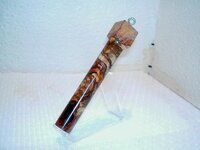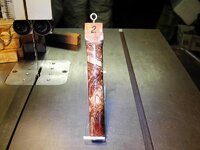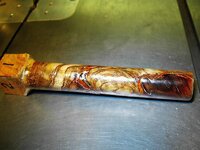Hi Ed,
Where do I start...???


:wink:
Well, I can assist you in relation to some of the Aussie woods, particularly the 44 LOCAL (SA) wood species I have processed at the moment into all sorts of blanks sizes and shapes and in this case, size does matter...!
Cutting most of these trees myself, I spend a considerable amount of time, trying no ways to improve the speed, quality and yield of these timbers and I can tell you, it is a battle...!:beat-up:
There is no such thing as a single rule to wood drying process or methods, indeed there more factors to consider them most people would imagine, and I can go though them if you wish (will be Christmas, before I'm done tough, sort of speak...!) but, I can resume/simplify your question with a few "golden rules" which do directly affect the wood dryness.
I will try to refer as much as possible to pen blanks, as these offer the best conditions (size) to achieve a dry stage in a shorter possible period of time (size matters, thing...!)
*- Most Kiln dry structured places, consider the "boards" dry or "cooked" as some call it, when the moisture content gauges reaches 12%. The boards are the preferred wood cut to allow the best drying results, speed and cell stabilization.
*- Some more sophisticated dry kilns do a immersion bath to the wood (boards) before they are moved to the kiln dry racks. This chemical treatment is rarely mentioned as some of the bath ingredients are toxic, and no I'm not talking about the green(ish) termite and and other rodents treatment that we find in posts and other external structures. This particular bath, stops wood from being affect with mould, and other fungi but it particularly replace the water as soon as the wood reaches about 55 to 60 degrees, while in the kiln. These woods come out with much better quality, stability and equilibrium, therefore reaching a high price, this mean that only some of the commercially valuable woods get this treatment.
*- Air drying wood, is never as quick and effective as the previous options. There tough a few interesting points that one should be aware of, such as, was the wood in boards, stacked, spaced in an open environment (to the elements/weather) or the boards were stacked and spaced stored under cover...???. Interestingly wood outside will dry quicker even if it gets wet from rain but will deteriorate and produce less clean wood (yield) at the processing stage, while the wood kept under cover have a better yield but will take in average 6 extra months to reach the same dry status...!
A piece from the outside racks of dry but wet (rain) wood will evaporate that excess moisture from the rain in a couple of days, depending of the environmental temperatures that wood will be exposed to. This wood will crack a lot less than the other wood dried under cover, if exposed to rain or any source of extreme moisture.
Sorry, I have to put the brakes right here as I'm getting on the Christmas time mood...!

:frown:
OK, most soft woods are quite safe to work with moisture content readings between 6 and 12%. Some dense but non-oily woods can be quite safe to work up to 18%, then we have the dense and oily woods, these will hardly reach anything under 10-12% regardless how dry, unless the natural oils have been sucked out though chemical treatment. Timbers suck as Olive wood, are perfectly workable up to 20% MC BUT, it all depend of you you handle it with all the pen making processes, there is, heat at those MC% levels will split/kill it. Blank drilling has to be done without allowing the bit and wood to get hot, and the finish is normally the second killer, particularly any sort of friction finish, that will guarantee a few air line cracks that can develop as you finish it or days later (1 week the most). Heat from the CA can spoil the blank also, I always recommend when working with olive wood and with a few other well known oily woods, if Ca is to be used, use thin CA and make sure the blank/barrel is cold again before applying the next coat. The thicker the CA the more heat will produce so, it will less risky to use the thin one.
Your problem with your CA finish separating from the wood on that pen you mention, was not due to water (extra moisture) in the blank. I do samples of my woods nearly everyday and most of them where done within 6 hours of the tree being cut, you could get any greener than that, unless the tree was dead, which isn't the case in most times. Between rounding a pen blank sample, use the sanding sealer and the first coat of Floorseal varnish, immediately after turning, with a second coat within a couple of days or give the CA finish directly into the green/wet turned sample, has never resulted in that sort of separation in may case. Green samples are harder to finish, regardless of what you use and the most common reaction afterwards is the shrinking and moving of the blank.
I just had a good example of this on the Almond burl blanks that I cut recently. I had posted a pic of one blank that was cut from the burl that day and the wood was cut from the tree a week before so there is no doubt there is/was really green. I tried to capture the natural and unique colours of these burled wood blanks before they would dramatically change to something else totally different if the burls were left untouched until dry. As I explained them, I used CA to achieve the best gloss/chine I could, for the pic that evening and before the wood would start drying/changing.
The finish was gloss and even all around on the pic (2/9/10), I have been keeping this blank in the computer room with me so that I could check it regularly and within 48 hours, the shrinking was starting to be noticeable, I'm going to take a pic of it in a minute, so that you and other members can see what the blank is doing but, that CA finish is as hard and stuck to the wood as if the wood was bone dry...!
I find much more sensible and economical for everyone, to get/buy the wood/blanks they want, as per the current wood condition the supplier is offering (as it become available). The risk is mutual, if the wood don't sell because is not ready to work with, and the supplier has to acquire drying kilns and/or nurse these woods/blanks until they are totally dry, many blanks will not make it and that is a fact regardless, then the blanks have the be sold at a premium price to cover the costs of the wood that didn't make it and interest of the money invested all that time waiting...!
In another words, green, semi-green wood/blanks are always cheaper that the very dry stuff, 30% to 50% less in most cases (most valued woods)...!
Moisture content gauges are a very handy and quite inexpensive tool to buy, mine cost me $50 landed in my place, they sell on eBay for about $30 bucks or so, I have this
one
These MC gauges read up to 40%, interestingly this is enough as a totally green and wet log reads between 37% and 40% so for the MC% readings on the world of woods, 40% is very green, 20% is half way there an 10% is the green light is most cases as explained previously.
Controlling MC% buy weight is also commonly used, you simply use digital scales (kitchen type will do), date it and record its weight, put it a side for a while (couple of weeks) and repeat the process, again record the weight and date it, when the blank stops loosing weight, its means it reached the balance within its environment and that means that the blanks is pretty much ready to turn...!:biggrin:
Attached is the pics of the Almond blank freshly finished and today. Is going to get a lot worse...!

hope not totally wasted, will see...!
I wish that would be a simple answer to you question, there is the same question we all battle with...!

:biggrin:
Cheers
George



